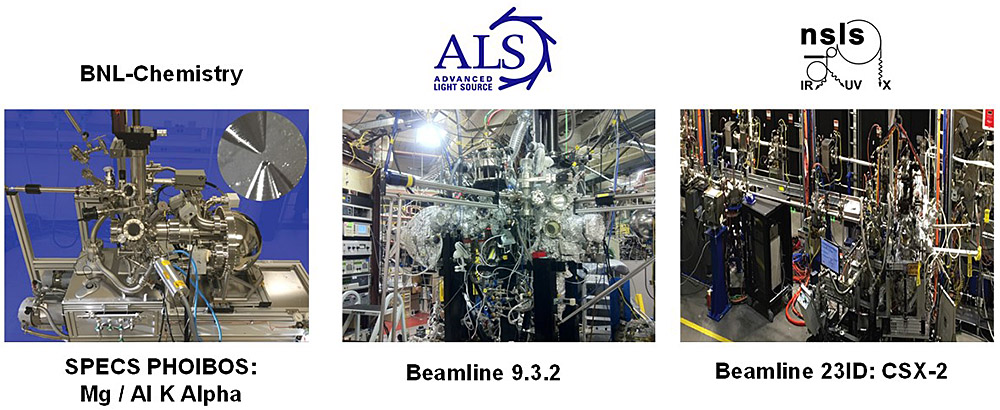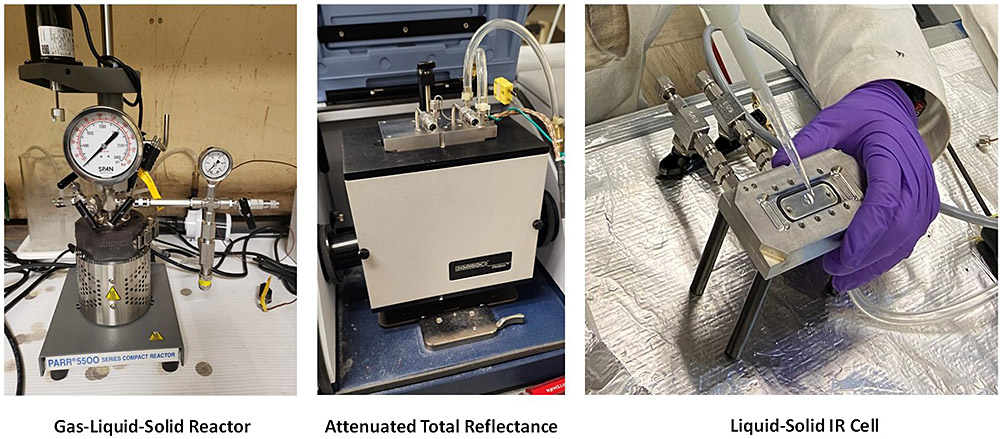- Home
-
Research Groups
Division Groups
- Artificial Photosynthesis
- Catalysis: Reactivity & Structure
- Electrochemical Energy Storage
- Electron- and Photo-Induced Processes for Molecular Energy Conversion
- Neutrino and Nuclear Chemistry
- Surface Electrochemistry and Electrocatalysis
Associated Groups
- Catalysis for Alternative Fuels Production
- Nanostructured Interfaces for Catalysis
- Structure and Dynamics of Applied Nanomaterials
- People
- Operations
- News
- Events

Catalysis: Reactivity and Structure
Development of techniques for in-situ characterization of model and powder catalysts.
We specialize in the application of soft X-ray ambient pressure spectroscopy (in house, at the Advanced Light Source (LBNL) and NSLS-II (BNL)), to evaluate reaction intermediates and surface states using carbon, oxygen and metal core levels to elucidate the reaction mechanism in reactions specific to the conversion of CO2 and CH4.

We have developed unique experimental capabilities to test the catalytic chemistry over liquid-solid-gas interactions using kinetic testing, infrared spectroscopy and soft X-rays.

The Catalysis Group at BNL is leading research initiatives into the development of new tools and techniques that focus on the characterization of heterogeneous catalytic reactions and catalysts using imaging, spectroscopy and scattering techniques and integrated combinations of them under reaction conditions to unravel the morphology, chemical and structural properties, of catalysts, respectively. These efforts revolve around the use of synchrotron radiation (NSLS), electrons (CFN) and quantum tunneling tools with particular thrusts into imaging, spectroscopy and scattering.
Group Instrumentation (BNL)
- Three UHV chambers with diverse instrumentation for surface characterization: LEED, UPS, XPS, AES, TPD, ISS, PM-AP-IRRAS, Reactivity Cell. All the systems include ancillary instrumentation such as sputtering guns and metal evaporators. The IRRAS system was retrofitted with an ambient pressure (AP) cell on top of the UHV system. The sample can be prepared and characterized in UHV and then transfer in vacuum to the AP cell.
- Two STM chambers. One variable temperature scanning tunneling microscope (STM) that allows cooling of the surface to 30 K and heating to 800 K. We have just installed a second variable temperature STM that allows the fast acquisition of surface images with high resolution in-situ from 130K to 875K. In the inset is shown the ambient pressure cell containing the STM inside the UHV system. The load lock chamber in the left will be used to transfer samples with the vacuum transfer setup to the other AP systems.
- An ambient pressure (AP) cell integrated with the STM allows changing the conditions from UHV up to 760 Torr, while maintaining in-situ scanning capabilities up to 750 K at 1 Torr.
- Several high-vacuum/inert gas manifolds for synthesis and sample preparation
BNL Facilities
Center for Functional Nanomaterials (CFN)
- Electron microscopy facility: HRTEM, HAADF-STEM, ETEM of powder catalysts
- Proximal probe facilities: LT-STM, V-STM, LEEM
Other User Facilities
Advanced Photon Source (APS-ANL)
- Beamline 9BMC : XANES and combined DRIFTS for in Operando study of powder catalysts
- Beamline 11ID: PDF and combined DRIFTS for in Operando study of powder catalysts
Advanced Light Source (ALS-LBNL)
- Beamline 9.3.2 : AP-XPS of model catalysts
Max-Lab (Lund, Sweden)
- Beamline I511: AP-XPS of model catalysts
Computational Facilities
Our theoretical efforts are supported by the following set of computational tools and clusters:
Computational tools and approaches include (packages noted)
- Quantum chemistry techniques including DFT based approaches as well as MP2, CASSCF, and coupled-cluster methods. (Turbomole, DMol3, NWChem, Q-Chem, Gaussian, SCM ADF)
- KMC simulations of competing reaction pathways. (KINETIX, local) Nano cluster at CFN, BNL; Middle: BGQ at BNL; Right: HOPPER at NERSC, LBNL.
- Solid-state techniques based on DFT, including ab initio molecular dynamics. (VASP, CASTEP, CP2K, Abinit, Quantum Espresso, SCM BAND)
- Excited state techniques based on many-body perturbation theory. (Abinit, Yambo, Quantum Espresso, Vasp, local)
- Classical molecular dynamics and coarse-grained simulations with empirical potentials. (LAMMPS, SCM Reactive MD with ReaxFF)
Computational clusters include:
- CFN computing facility
- NYBlue computing facility
- NERSC computing facility (which is the primary scientific computing facility for the Office of Science in the U.S. Department of Energy.)




